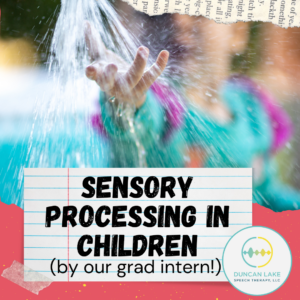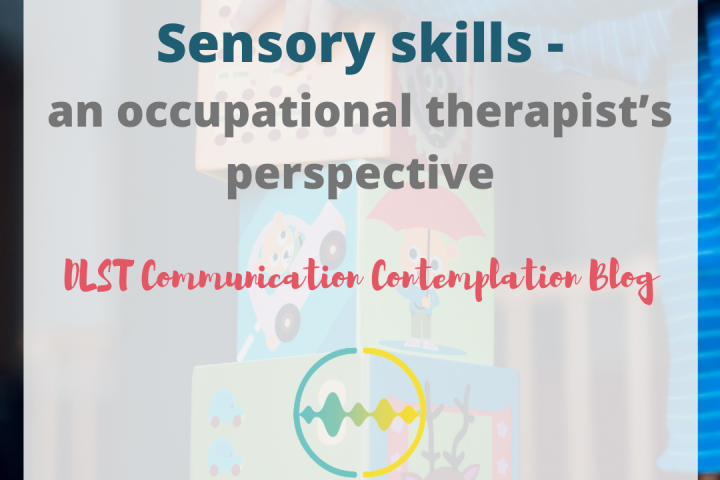By Katelynn Harris, St. Mary’s College
Duncan Lake Speech Therapy Graduate Intern
Sensory processing is the way in which the body processes internal and external sensory information. When part or parts of the sensory system are not working properly, a child can become dysregulated. This means they are not in a state of optimal arousal which can cause drastic changes in mood because the child is simply overwhelmed. There are different types of sensory processing systems but the focus of this blog post is the vestibular and proprioceptive systems, and how stimulating these systems can lead to an increased state of arousal and better self-regulation.

The vestibular system, controlled by the cerebellum and housed within the inner ear, helps maintain an individual’s sense of balance and center of gravity. The vestibular system plays a major role in controlling our balance and the movements of our eyes. Auditory processing and communication can be negatively affected when the vestibular system is damaged, and symptoms of vertigo and dizziness may occur. In children, difficulties in regulating the vestibular system may result in additional physiological symptoms. Common“red flags” in children who have trouble with vestibular management include poor balance, low muscle tone, the need for constant motion, poor hand-eye coordination, difficulty controlling both sides of the body simultaneously, and avoiding activities like jumping or climbing. (1)
If you are working with a child who exhibits these traits, the following activities could help regulate their vestibular system: swinging or rocking back and forth, walking on a balance beam or using a balance board, wheelbarrow walking, army crawling, riding a scooter board, going down a slide, swimming, and log rolling. All of these activities help soothe the vestibular system and allow the child to better focus their attention and successfully control their body.(1)
The proprioceptive system, controlled by the brainstem along with the cerebellum, involves processing feedback from muscles, joints, and tendons. The proprioceptive system reads signals sent from the body to determine the effort required to carry out movements. Children who struggle to regulate their proprioceptive system tend to have trouble with motor planning and movement regulation. Common “red flags” for insufficient proprioceptive management include: frequently jumping and crashing, frequently bumping into objects, the inability to apply appropriate force, appearing clumsy, having poor spatial awareness of their body, and biting or chewing on nonfood items.(2)
When working with a child who exhibits these traits, try incorporating weight-bearing activities. Bear crawls, crab walks, resistive activities like pushing and pulling objects, yoga or other core-engaging exercises, lifting heavy objects, and deep pressure input are all excellent options to improve proprioceptive system processing. All of the activities listed above are helpful in orienting the child’s body to their environment and increasing their ability to maintain their focus.(1)
Children who have difficulties with vestibular or proprioceptive inputs can also be hypersensitive or hyposensitive to stimuli like lights, noises, and movements. A child who is hypersensitive may struggle to participate in environments with bright lights and sounds. Hypersensitive children may also have aversions to different textures of foods, textiles, tastes, and/or smells. Conversely, hypo-reactive children may shut down or not acknowledge loud sounds or stimuli that they may find painful, and occasionally they may become unresponsive to people or objects within their environment. (3)
Hypersensitive children often find that slower swinging, sucking on different objects, white noise, tight hugs, and fidget toys can help them reach their optimal levels of arousal which may increase their ability to focus on tasks and remain well-regulated. For hyposensitive children, bouncing, jumping, fast-paced music, and playing in cold water can improve attention and focus because such activities help increase alertness. (3)
By increasing or decreasing input to the vestibular and/or proprioceptive systems, children can begin to reach optimal arousal levels and increase their ability to focus on various tasks and remain well-regulated. Some research suggests that implementing sensory-based activities into therapeutic sessions may yield positive outcomes in communication, play, and academic participation for children with sensory processing difficulties.3 Implementing sensory-based activities can be a critical tool for educators, therapists, and parents to unlock and understand a child’s full potential.
If you feel your child has a sensory processing disorder, we encourage you to talk to their speech therapist and/or seek out an occupational therapist for further evaluation and information.
1. The OT Toolbox. (2021). [Types of sensory processing disorders]. Map. https://theottoolbox.com
2. Sensory discrimination disorder. (2018, August 27). Sensory Processing Disorder. https://sinetwork.org/
3. Van Rie, G. L., & Heflin, L. J. (2009). The effect of sensory activities on correct responding for children with autism spectrum disorders. Research in Autism Spectrum Disorders, 3(3), 783-796. https://doi.org/10.1016/j.rasd.2009.03.001



What a great article! Thank you for educating us.